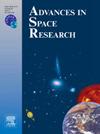Investigation of the global Ionospheric response to 2015 geomagnetic storms using SAMI3 simulations and SWARM satellite data
IF 2.8
3区 地球科学
Q2 ASTRONOMY & ASTROPHYSICS
引用次数: 0
Abstract
This paper examines the effects of two solar storms in March and June 2015 on the Earth’s ionosphere. For this purpose, three-dimensional simulations of the SAMI model have been used, in which the zonal and meridional neutral wind speed, as well as the electron temperature and electron density at a fixed longitude of 60 degrees, have been analyzed. The simulation results of temperature and electron density have been compared with satellite data. The findings show that in both storms, electron temperature increased significantly on the day of the storm and the day after. A strong enhancement of neutral wind is predicted. The general pattern of meridional and zonal winds is conserved but expanded over larger latitude regions. In addition, the equatorial ionization anomaly (EIA) is observed in the electron density simulations for March 15, 16, and 17, while on March 18, this anomaly is weakened and the Spread-F phenomenon is formed instead. Also, the results of TEC modeling on a global scale using the three-dimensional SAMI model have been examined, and significant changes have been shown in response to these storms. The storm of June 2015 was similarly investigated and significant changes in the electron temperature were observed. Moreover, the simulations revealed that sporadic-E layer between mid- to high-latitudes starts to form on storm day. Such enhancement in Es layer formation has been investigated in this paper.
利用SAMI3模拟和SWARM卫星数据研究全球电离层对2015年地磁风暴的响应
本文研究了2015年3月和6月的两次太阳风暴对地球电离层的影响。为此,利用SAMI模式的三维模拟,分析了纬向和经向中性风速,以及固定经度60度处的电子温度和电子密度。温度和电子密度的模拟结果与卫星数据进行了比较。结果表明,在两场风暴中,电子温度在风暴当天和风暴后的第二天都显著升高。预计中性风会有较强的增强。经向风和纬向风的一般模式保持不变,但在较大的纬度地区有所扩展。另外,在3月15日、16日和17日的电子密度模拟中观测到赤道电离异常(EIA),而在3月18日,这种异常减弱,形成了扩散- f现象。此外,使用三维SAMI模式在全球范围内对TEC模拟的结果进行了检验,并显示出对这些风暴的响应发生了重大变化。对2015年6月的风暴进行了类似的调查,观察到电子温度的显著变化。此外,模拟结果表明,中高纬度地区之间的散散e层在风暴日开始形成。本文对Es层形成中的这种增强进行了研究。
本文章由计算机程序翻译,如有差异,请以英文原文为准。
求助全文
约1分钟内获得全文
求助全文
来源期刊

Advances in Space Research
地学天文-地球科学综合
CiteScore
5.20
自引率
11.50%
发文量
800
审稿时长
5.8 months
期刊介绍:
The COSPAR publication Advances in Space Research (ASR) is an open journal covering all areas of space research including: space studies of the Earth''s surface, meteorology, climate, the Earth-Moon system, planets and small bodies of the solar system, upper atmospheres, ionospheres and magnetospheres of the Earth and planets including reference atmospheres, space plasmas in the solar system, astrophysics from space, materials sciences in space, fundamental physics in space, space debris, space weather, Earth observations of space phenomena, etc.
NB: Please note that manuscripts related to life sciences as related to space are no more accepted for submission to Advances in Space Research. Such manuscripts should now be submitted to the new COSPAR Journal Life Sciences in Space Research (LSSR).
All submissions are reviewed by two scientists in the field. COSPAR is an interdisciplinary scientific organization concerned with the progress of space research on an international scale. Operating under the rules of ICSU, COSPAR ignores political considerations and considers all questions solely from the scientific viewpoint.
 求助内容:
求助内容: 应助结果提醒方式:
应助结果提醒方式:


